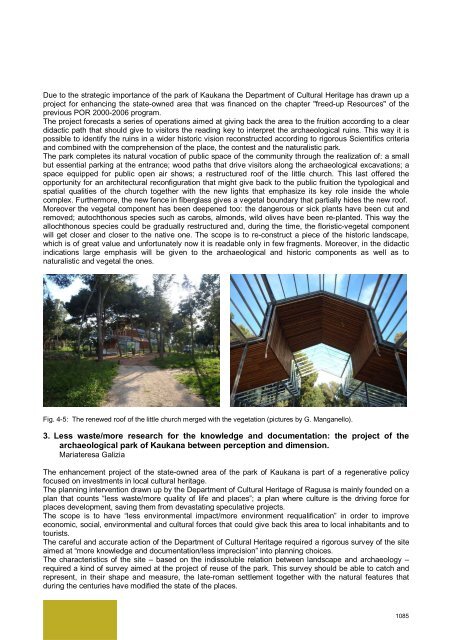Archaeology and nature: hyblean cultural landscape and territorial ...
Archaeology and nature: hyblean cultural landscape and territorial ...
Archaeology and nature: hyblean cultural landscape and territorial ...
You also want an ePaper? Increase the reach of your titles
YUMPU automatically turns print PDFs into web optimized ePapers that Google loves.
Due to the strategic importance of the park of Kaukana the Department of Cultural Heritage has drawn up a<br />
project for enhancing the state-owned area that was financed on the chapter "freed-up Resources" of the<br />
previous POR 2000-2006 program.<br />
The project forecasts a series of operations aimed at giving back the area to the fruition according to a clear<br />
didactic path that should give to visitors the reading key to interpret the archaeological ruins. This way it is<br />
possible to identify the ruins in a wider historic vision reconstructed according to rigorous Scientifics criteria<br />
<strong>and</strong> combined with the comprehension of the place, the contest <strong>and</strong> the naturalistic park.<br />
The park completes its natural vocation of public space of the community through the realization of: a small<br />
but essential parking at the entrance; wood paths that drive visitors along the archaeological excavations; a<br />
space equipped for public open air shows; a restructured roof of the little church. This last offered the<br />
opportunity for an architectural reconfiguration that might give back to the public fruition the typological <strong>and</strong><br />
spatial qualities of the church together with the new lights that emphasize its key role inside the whole<br />
complex. Furthermore, the new fence in fiberglass gives a vegetal boundary that partially hides the new roof.<br />
Moreover the vegetal component has been deepened too: the dangerous or sick plants have been cut <strong>and</strong><br />
removed; autochthonous species such as carobs, almonds, wild olives have been re-planted. This way the<br />
allochthonous species could be gradually restructured <strong>and</strong>, during the time, the floristic-vegetal component<br />
will get closer <strong>and</strong> closer to the native one. The scope is to re-construct a piece of the historic l<strong>and</strong>scape,<br />
which is of great value <strong>and</strong> unfortunately now it is readable only in few fragments. Moreover, in the didactic<br />
indications large emphasis will be given to the archaeological <strong>and</strong> historic components as well as to<br />
naturalistic <strong>and</strong> vegetal the ones.<br />
Fig. 4-5: The renewed roof of the little church merged with the vegetation (pictures by G. Manganello).<br />
3. Less waste/more research for the knowledge <strong>and</strong> documentation: the project of the<br />
archaeological park of Kaukana between perception <strong>and</strong> dimension.<br />
Mariateresa Galizia<br />
The enhancement project of the state-owned area of the park of Kaukana is part of a regenerative policy<br />
focused on investments in local <strong>cultural</strong> heritage.<br />
The planning intervention drawn up by the Department of Cultural Heritage of Ragusa is mainly founded on a<br />
plan that counts “less waste/more quality of life <strong>and</strong> places”; a plan where culture is the driving force for<br />
places development, saving them from devastating speculative projects.<br />
The scope is to have “less environmental impact/more environment requalification” in order to improve<br />
economic, social, environmental <strong>and</strong> <strong>cultural</strong> forces that could give back this area to local inhabitants <strong>and</strong> to<br />
tourists.<br />
The careful <strong>and</strong> accurate action of the Department of Cultural Heritage required a rigorous survey of the site<br />
aimed at “more knowledge <strong>and</strong> documentation/less imprecision” into planning choices.<br />
The characteristics of the site – based on the indissoluble relation between l<strong>and</strong>scape <strong>and</strong> archaeology –<br />
required a kind of survey aimed at the project of reuse of the park. This survey should be able to catch <strong>and</strong><br />
represent, in their shape <strong>and</strong> measure, the late-roman settlement together with the natural features that<br />
during the centuries have modified the state of the places.<br />
1085
















